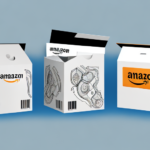Comparing Amazon FBA vs FBM: Which Is the Best Option for Your Business?
If you are selling products on Amazon, you may have heard about two different fulfillment methods: FBA (Fulfilled by Amazon) and FBM (Fulfilled by Merchant). Both options have their own advantages and disadvantages, but it ultimately comes down to your business's specific needs and goals. This article provides an in-depth analysis of the differences between Amazon FBA and FBM, including costs, benefits, and critical factors to consider when choosing between the two options.
Introduction to Amazon FBA and FBM
Amazon FBA is a fulfillment method where you ship your products to Amazon's warehouses, and they handle the packaging, shipping, and customer service for those products. This means that Amazon manages the logistics of storing, packing, and delivering your items to customers. FBM, on the other hand, means that you handle the fulfillment process yourself, which includes storing, packing, and shipping your products directly to customers.
One significant advantage of using Amazon FBA is the ability to leverage Amazon's vast customer base and Prime shipping options. This can lead to increased sales and higher customer satisfaction. Additionally, FBA can save you time and money by outsourcing the fulfillment process, allowing you to focus on other aspects of your business such as product development and marketing.
However, FBM also has its strengths, especially for smaller businesses or those with unique products. By managing the fulfillment process yourself, you have greater control over packaging and shipping, enabling a more personalized and branded experience for your customers. FBM can also be more cost-effective for certain products or businesses with lower sales volumes.
Benefits of Using Amazon FBA for Your Business
Amazon FBA has gained popularity among sellers due to its numerous benefits, including:
- Prime Eligibility: Amazon Prime members can enjoy free and fast shipping with FBA products, increasing your sales and enhancing product visibility.
- Customer Service: Amazon manages customer service and returns on your behalf, saving you time and effort.
- Scalability: With FBA, you can easily scale your business as Amazon handles storage, fulfillment, and shipping.
In addition to these benefits, Amazon FBA provides access to Amazon's global customer base. By using FBA, your products can reach customers in different countries, helping you expand your business and boost revenue. Moreover, FBA offers competitive pricing for storage and shipping, which can help you save money and increase your profit margins. Overall, Amazon FBA is an excellent option for businesses looking to streamline operations and reach a wider audience.
Benefits of Using Amazon FBM for Your Business
Although FBM doesn't offer the same level of convenience as FBA, it still presents several advantages:
- Cost Savings: FBM can be more cost-effective, especially for new businesses with smaller inventories.
- Greater Control: With FBM, you maintain control over the entire fulfillment process, allowing for a more personalized customer experience and direct customer relationships.
- Shipping Options: FBM allows you to use your preferred carriers and shipping methods, providing flexibility in how you deliver products.
Another advantage of using Amazon FBM is the ability to sell products that are not eligible for FBA, such as fragile, oversized, or items requiring special handling. Additionally, FBM is beneficial if you have a local or regional customer base, enabling faster delivery times and potentially lower shipping costs for customers in your area.
Understanding the Costs Associated with Amazon FBA and FBM
Both FBA and FBM come with their own sets of costs. Understanding these can help you make an informed decision:
Amazon FBA Costs
- Storage Fees: Based on the size and space your products occupy in Amazon's warehouse.
- Pick and Pack Fee: Charged for each unit picked and packed by Amazon for each order.
- Shipping Fees: Charged for shipping from Amazon's warehouse to the customer.
- Fulfillment Fee: A flat fee per unit sold that covers all of Amazon's fulfillment costs.
Amazon FBM Costs
- Storage Costs: Costs associated with storing your products, such as warehousing fees.
- Packaging Materials: Expenses for packaging materials you must provide.
- Shipping Costs: Costs you incur for shipping and delivering each order.
- Customer Service Costs: Managing customer service inquiries and returns yourself.
It's important to note that while FBM may appear cheaper initially, it can sometimes result in higher overall costs. FBA offers Prime shipping, which can boost sales and customer satisfaction. Additionally, FBA handles fulfillment and shipping, saving you time and resources that can be directed toward business growth.
Comparing the Fees Charged by Amazon FBA and FBM
When comparing FBA and FBM, it's crucial to understand the cost differences to determine which method suits your business best:
- FBA Fees: Generally higher than FBM fees but offer greater convenience and services.
- FBM Fees: Lower fees but require you to manage the fulfillment process independently.
- Inventory Size: FBM may be more cost-effective for small inventories, while FBA can offer discounted rates on shipping and storage for larger inventories.
Consider the potential impact on customer experience when choosing between FBA and FBM. FBA handles shipping and customer service, potentially leading to faster delivery times and higher customer satisfaction. In contrast, FBM gives you more control over fulfillment, allowing for personalized customer service. Your choice should align with your business's specific needs and priorities.
How to Choose Between Amazon FBA and FBM for Your Business
When deciding between FBA and FBM, consider the following factors:
- Inventory Size: Larger inventories may benefit more from FBA's scalability.
- Fulfillment Management: Assess your ability to manage the fulfillment process yourself.
- Customer Service: Determine the level of customer service you can provide independently.
- Cost Analysis: Compare the costs associated with each method relative to your budget.
Pros and Cons of Using Amazon FBA for Your Business
Pros:
- Higher visibility for your products.
- Time-saving, as Amazon handles all logistics and customer service.
- Scalability, allowing your business to grow effortlessly.
- Prime eligibility, offering customers free and fast shipping.
Cons:
- Higher costs due to storage, picking, packing, and shipping fees.
- Less control over the fulfillment process.
- Potential long-term storage fees if products do not sell.
Pros and Cons of Using Amazon FBM for Your Business
Pros:
- Lower costs, as you are not charged for Amazon's fulfillment services.
- Greater control over the fulfillment process.
- Ability to personalize the customer experience.
Cons:
- Less visibility for your products compared to FBA.
- More time and effort required to manage the entire fulfillment process.
- Limited Prime eligibility, potentially reducing appeal to Prime members.
How to Set Up an Amazon FBA Account for Your Business
Setting up an FBA account involves several steps:
- Create an Amazon seller account: If you don't already have one, sign up for an Amazon Seller Central account.
- Select the FBA option: In your account settings, choose the FBA fulfillment method.
- Prepare and ship your products: Send your inventory to one of Amazon's fulfillment centers.
- Set your pricing and manage inventory: Use your Amazon seller account to set prices and monitor inventory levels.
How to Set Up an Amazon FBM Account for Your Business
Setting up an FBM account is straightforward:
- Create an Amazon seller account: Register for an Amazon Seller Central account if you haven't already.
- List your products: Add your products to the Amazon marketplace and choose FBM as your fulfillment method.
- Manage shipping: Handle the shipping process yourself, ensuring timely delivery to customers.
- Manage inventory and pricing: Use your Amazon seller account to oversee inventory levels and set competitive pricing.
Tips for Maximizing Sales on Amazon with Either Option
Regardless of whether you choose FBA or FBM, the following strategies can help maximize your sales on Amazon:
- Optimize Product Listings: Use detailed descriptions, high-quality images, and relevant keywords to enhance your listings.
- Competitive Pricing and Promotions: Offer attractive pricing and run promotions to attract and retain customers.
- Utilize Amazon Advertising: Invest in Amazon's advertising services to increase product visibility.
- Encourage Customer Reviews: Prompt customers to leave reviews and feedback to build trust and credibility.
Case Studies: Successful Businesses That Use Amazon FBA or FBM
Many businesses have successfully utilized both Amazon FBA and FBM. Here are some notable examples:
- FBA Example: TheraBreath – A dental care company that increased their sales by over 70% after switching to FBA. By outsourcing logistics and customer service to Amazon, they could focus more on product development and marketing.
- FBM Example: Rustic Art – A handmade soap and skincare company based in India uses FBM to maintain control over the fulfillment process, providing a personalized experience for their customers while saving on fees by handling logistics themselves.
Frequently Asked Questions About Amazon FBA and FBM
Q: Which is better for a small business: FBA or FBM?
A: It depends on your business's specific needs and goals. FBM can be more cost-effective for small businesses with smaller inventories, while FBA offers greater convenience and scalability.
Q: Can I use both FBA and FBM for my products?
A: Yes, you can use both. This approach can be beneficial if you have products that are better suited for one fulfillment method over the other.
Q: How do I calculate my FBA fees?
A: Amazon provides a FBA fee calculator tool available in your seller account to help you estimate your FBA fees based on product specifications.
Conclusion: Which Option Is Best for Your Business?
There is no one-size-fits-all answer to whether FBA or FBM is best for your business. The decision ultimately depends on your specific needs, goals, and budget. If you seek convenience, scalability, and Prime eligibility, FBA may be the best choice. If you prefer greater control over the fulfillment process and lower costs, FBM might be more suitable. Consider all the factors discussed in this article to choose the option that aligns best with your business objectives.




















